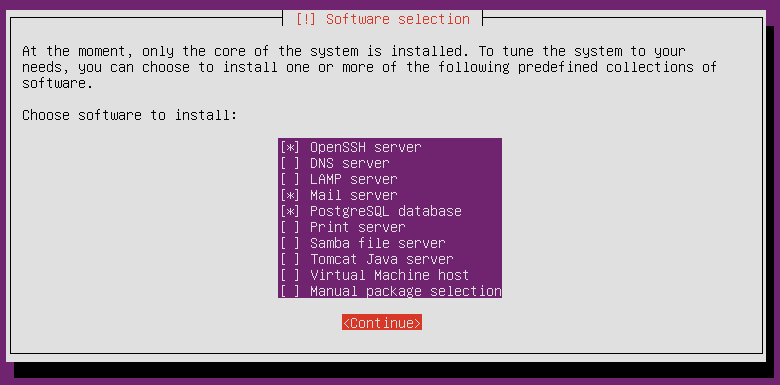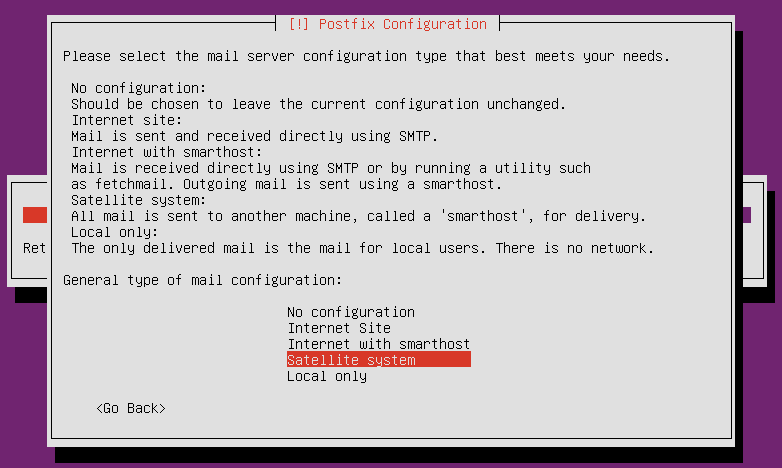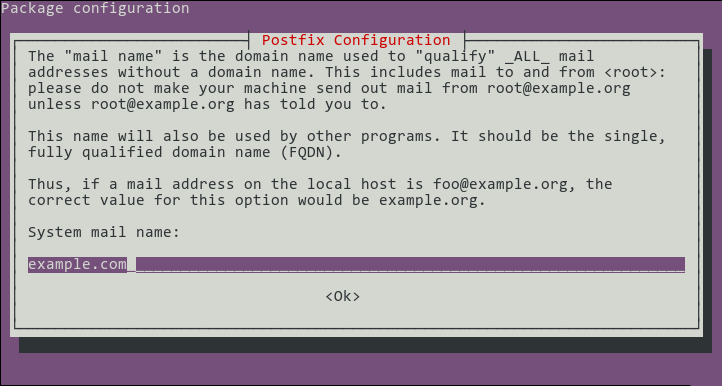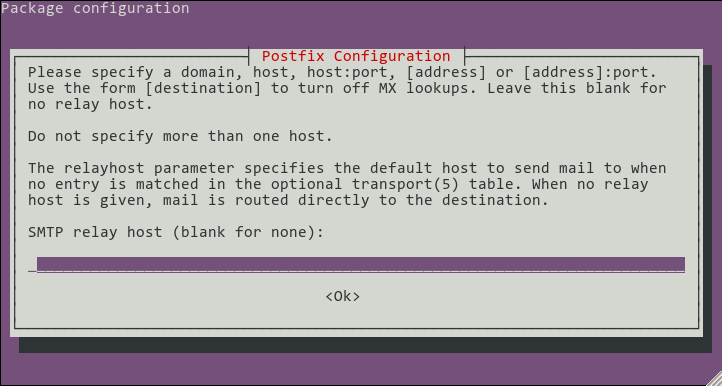mirror of
https://github.com/codeninjasllc/discourse.git
synced 2024-11-24 16:18:42 -05:00
316 lines
11 KiB
Markdown
316 lines
11 KiB
Markdown
# Discourse Install Guide on Ubuntu
|
|
|
|
## Install Ubuntu 12.04 with the package groups:
|
|
|
|

|
|
|
|
* Basic ubuntu server
|
|
* OpenSSH server
|
|
* Mail server
|
|
* PostgreSQL database (9.1+)
|
|
|
|
You may be working on an already-installed or automatically deployed system, in which case you can install them afterwards:
|
|
|
|
# Run these commands as your normal login (e.g. "michael")
|
|
sudo apt-get update && sudo apt-get -y upgrade
|
|
sudo tasksel install openssh-server
|
|
sudo tasksel install mail-server
|
|
sudo tasksel install postgresql-server
|
|
|
|
### Configure the mail server:
|
|
|
|

|
|
|
|
In our example setup, we're going to configure as a 'Satellite system', forwarding all mail to our egress servers for delivery. You'll probably want to do that unless you're handling mail on the same machine as the Discourse software.
|
|
|
|

|
|
|
|
You probably want to configure your 'mail name' to be the base name of your domain. Note that this does not affect any email sent out by Discourse itself, just unqualified mail generated by systems programs.
|
|
|
|

|
|
|
|
If you have a mail server responsible for handling the egress of email from your network, enter it here. Otherwise, leave it blank.
|
|
|
|
## Additional system packages
|
|
|
|
Install necessary packages:
|
|
|
|
# Run these commands as your normal login (e.g. "michael")
|
|
sudo apt-get -y install build-essential libssl-dev libyaml-dev git libtool libxslt-dev libxml2-dev redis-server libpq-dev gawk curl pngcrush
|
|
|
|
## Web Server Option: nginx
|
|
|
|
At Discourse, we recommend the latest version of nginx (we like the new and
|
|
shiny). To install on Ubuntu:
|
|
|
|
# Run these commands as your normal login (e.g. "michael")
|
|
# Remove any existing versions of nginx
|
|
sudo apt-get remove '^nginx.*$'
|
|
|
|
# Add nginx repo to sources.list
|
|
cat <<'EOF' | sudo tee -a /etc/apt/sources.list
|
|
|
|
deb http://nginx.org/packages/ubuntu/ precise nginx
|
|
deb-src http://nginx.org/packages/ubuntu/ precise nginx
|
|
EOF
|
|
|
|
# Add nginx key
|
|
curl http://nginx.org/keys/nginx_signing.key | sudo apt-key add -
|
|
|
|
# install nginx
|
|
sudo apt-get update && sudo apt-get -y install nginx
|
|
|
|
## Web Server Option: apache2
|
|
|
|
If you instead want to use apache2 to serve the static pages:
|
|
|
|
# Run these commands as your normal login (e.g. "michael")
|
|
# If you don't have apache2 yet
|
|
sudo apt-get install apache2
|
|
|
|
# Edit your site details in a new apache2 config file
|
|
sudo vim /etc/apache2/sites-available/your-domain.com
|
|
|
|
# Put these info inside and change accordingly
|
|
|
|
<VirtualHost *:80>
|
|
ServerName your-domain.com
|
|
ServerAlias www.your-domain.com
|
|
|
|
DocumentRoot /srv/www/apps/discourse/public
|
|
|
|
<Directory /srv/www/apps/discourse/public>
|
|
AllowOverride all
|
|
Options -MultiViews
|
|
</Directory>
|
|
|
|
# Custom log file locations
|
|
ErrorLog /srv/www/apps/discourse/log/error.log
|
|
CustomLog /srv/www/apps/discourse/access.log combined
|
|
</VirtualHost>
|
|
|
|
# Install the Passenger Phusion gem and run the install
|
|
gem install passenger
|
|
passenger-install-apache2-module
|
|
|
|
# Next, we "create" a new apache2 module, passenger
|
|
sudo vim /etc/apache2/mods-available/passenger.load
|
|
|
|
# Inside paste (change the user accodingly)
|
|
LoadModule passenger_module /home/YOUR-USER/.rvm/gems/ruby-2.0.0-p0/gems/passenger-4.0.2/libout/apache2/mod_passenger.so
|
|
|
|
# Now the passenger module configuration
|
|
sudo vim /etc/apache2/mods-available/passenger.conf
|
|
|
|
# Inside, paste (change the user accodingly)
|
|
PassengerRoot /home/YOUR-USER/.rvm/gems/ruby-2.0.0-p0/gems/passenger-4.0.2
|
|
PassengerDefaultRuby /home/YOUR-USER/.rvm/wrappers/ruby-2.0.0-p0/ruby
|
|
|
|
# Now activate them all
|
|
|
|
sudo a2nsite your-domain.com
|
|
sudo a2enmod passenger
|
|
sudo service apache2 reload
|
|
sudo service apache2 restart
|
|
|
|
If you get any errors starting or reloading apache, please check the paths above - Ruby 2.0 should be there if you are using RVM, but it could get tricky.
|
|
|
|
## Install rvm and ruby environment
|
|
|
|
### RVM Option: Systemwide installation
|
|
|
|
Taken from http://rvm.io/, the commands below installs RVM and users in the 'rvm' group have access to modify state:
|
|
|
|
# Run these commands as your normal login (e.g. "michael")
|
|
\curl -s -S -L https://get.rvm.io | sudo bash -s stable
|
|
sudo adduser $USER rvm
|
|
newgrp rvm
|
|
. /etc/profile.d/rvm.sh
|
|
rvm requirements
|
|
|
|
# Build and install ruby
|
|
rvm install 2.0.0
|
|
gem install bundler
|
|
|
|
### RVM Option: Single-user installation
|
|
|
|
Another sensible option (especially if only one Ruby app is on the machine) is
|
|
to install RVM isolated to a user's environment. Further instructions are
|
|
below.
|
|
|
|
## Discourse setup
|
|
|
|
Create discourse user:
|
|
|
|
# Run these commands as your normal login (e.g. "michael")
|
|
sudo adduser --shell /bin/bash discourse
|
|
# If this fails, it's because you're doing the RVM single-user install.
|
|
# In that case, you could just not run it if errors make you squirrely
|
|
sudo adduser discourse rvm
|
|
|
|
Give postgres DB rights to the `discourse` user:
|
|
|
|
# Run these commands as your normal login (e.g. "michael")
|
|
sudo -u postgres createuser -s discourse
|
|
sudo -u postgres psql -c "alter user discourse password 'todayisagooddaytovi';"
|
|
|
|
Change to the 'discourse' user:
|
|
|
|
# Run this command as your normal login (e.g. "michael"), further commands should be run as 'discourse'
|
|
sudo su - discourse
|
|
|
|
Install RVM if doing a single-user RVM installation:
|
|
|
|
# As 'discourse'
|
|
# Install RVM
|
|
\curl -s -S -L https://get.rvm.io | bash -s stable
|
|
. ~/.bash_profile
|
|
|
|
# rvm added shell initialization code to ~/.bash_profile,
|
|
# move it to ~/.profile instead
|
|
cat ~/.bash_profile >> ~/.profile
|
|
rm ~/.bash_profile
|
|
|
|
# Install necessary packages for building ruby
|
|
rvm requirements
|
|
|
|
# If discourse does not have sudo permissions (likely the case), run:
|
|
rvm --autolibs=read-fail requirements
|
|
# and rvm will tell you which packages you (or your sysadmin) need
|
|
# to install before it can proceed. Do that and then resume next:
|
|
|
|
Continue with discourse installation
|
|
|
|
# Build and install ruby
|
|
rvm install 2.0.0
|
|
gem install bundler
|
|
|
|
# Pull down the latest release
|
|
git clone git://github.com/discourse/discourse.git
|
|
cd discourse
|
|
git checkout latest-release
|
|
|
|
# Install necessary gems
|
|
bundle install --deployment --without test
|
|
|
|
_If you have errors building the native extensions, ensure you have sufficient free system memory. 1GB with no swap isn't enough, we recommend having 2GB as a minimum._
|
|
|
|
Configure discourse:
|
|
|
|
# Run these commands as the discourse user
|
|
cd ~/discourse/config
|
|
cp database.yml.production-sample database.yml
|
|
cp redis.yml.sample redis.yml
|
|
cp discourse.pill.sample discourse.pill
|
|
cp environments/production.rb.sample environments/production.rb
|
|
|
|
Edit discourse/config/database.yml
|
|
|
|
- change production db name if appropriate
|
|
- change username/password if appropriate
|
|
- set db_id if using multisite
|
|
- change `host_names` to the name you'll use to access the discourse site
|
|
|
|
Edit discourse/config/redis.yml
|
|
|
|
- no changes if this is the only application using redis, but have a look
|
|
|
|
Edit discourse/config/discourse.pill
|
|
|
|
- change application name from 'discourse' if necessary
|
|
- Ensure appropriate Bluepill.application line is uncommented
|
|
- search for "host to run on" and change to current hostname
|
|
- note: clockwork should run on only one host
|
|
|
|
Edit discourse/config/initializers/secret_token.rb
|
|
|
|
- uncomment secret_token line
|
|
- replace SET_SECRET_HERE with secret output from 'rake secret' command in discourse directory
|
|
- delete the lines below as per instructions in the file
|
|
|
|
Edit discourse/config/environments/production.rb
|
|
- check settings, modify smtp settings if necessary
|
|
- See http://meta.discourse.org/t/all-of-my-internal-users-show-as-coming-from-127-0-0-1/6607 if this will serve "internal" users
|
|
|
|
Initialize the database:
|
|
|
|
# Run these commands as the discourse user
|
|
# The database name here should match the production one in database.yml
|
|
createdb discourse_prod
|
|
RUBY_GC_MALLOC_LIMIT=90000000 RAILS_ENV=production rake db:migrate
|
|
RUBY_GC_MALLOC_LIMIT=90000000 RAILS_ENV=production rake assets:precompile
|
|
|
|
## nginx setup
|
|
|
|
# Run these commands as your normal login (e.g. "michael")
|
|
sudo cp ~discourse/discourse/config/nginx.sample.conf /etc/nginx/conf.d/discourse.conf
|
|
|
|
Edit /etc/nginx/nginx.conf:
|
|
|
|
- add: `server_names_hash_bucket_size 64;` to the `http` section
|
|
- uncomment: `gzip on;`
|
|
|
|
Edit /etc/nginx/conf.d/discourse.conf
|
|
|
|
- edit `server_name`. Example: `server_name cain.discourse.org test.cain.discourse.org;`
|
|
- change socket paths if discourse is installed to a different location
|
|
- modify root location if discourse is installed to a different location
|
|
|
|
Reload nginx by running
|
|
|
|
# Run as your normal login (e.g. "michael")
|
|
sudo /etc/init.d/nginx reload
|
|
|
|
## Bluepill setup
|
|
|
|
Configure bluepill:
|
|
|
|
# Run these commands as the discourse user
|
|
gem install bluepill
|
|
echo 'alias bluepill="NOEXEC_DISABLE=1 bluepill --no-privileged -c ~/.bluepill"' >> ~/.bash_aliases
|
|
rvm wrapper $(rvm current) bootup bluepill
|
|
rvm wrapper $(rvm current) bootup bundle
|
|
|
|
Start Discourse:
|
|
|
|
# Run these commands as the discourse user
|
|
RUBY_GC_MALLOC_LIMIT=90000000 RAILS_ROOT=~/discourse RAILS_ENV=production NUM_WEBS=4 bluepill --no-privileged -c ~/.bluepill load ~/discourse/config/discourse.pill
|
|
|
|
Add the bluepill startup to crontab.
|
|
|
|
# Run these commands as the discourse user
|
|
crontab -e
|
|
|
|
Add the following line:
|
|
|
|
@reboot RUBY_GC_MALLOC_LIMIT=90000000 RAILS_ROOT=~/discourse RAILS_ENV=production NUM_WEBS=4 /home/discourse/.rvm/bin/bootup_bluepill --no-privileged -c ~/.bluepill load ~/discourse/config/discourse.pill
|
|
|
|
Congratulations! You've got Discourse installed and running!
|
|
|
|
Now make yourself an administrator account. Browse to your discourse instance
|
|
and create an account by logging in normally, then run the commands:
|
|
|
|
# Run these commands as the discourse user
|
|
cd ~/discourse
|
|
RAILS_ENV=production bundle exec rails c
|
|
|
|
# (in rails console)
|
|
> me = User.find_by_username_or_email('myemailaddress@me.com')[0]
|
|
> me.admin = true
|
|
> me.save
|
|
|
|
## Updating Discourse
|
|
|
|
# Run these commands as the discourse user
|
|
bluepill stop
|
|
# Pull down the latest release
|
|
cd ~/discourse
|
|
git checkout master
|
|
git pull
|
|
git fetch --tags
|
|
# To run on the latest version instead of bleeding-edge:
|
|
#git checkout latest-release
|
|
bundle install --without test --deployment
|
|
RUBY_GC_MALLOC_LIMIT=90000000 RAILS_ENV=production rake db:migrate
|
|
RUBY_GC_MALLOC_LIMIT=90000000 RAILS_ENV=production rake assets:precompile
|
|
bluepill start
|